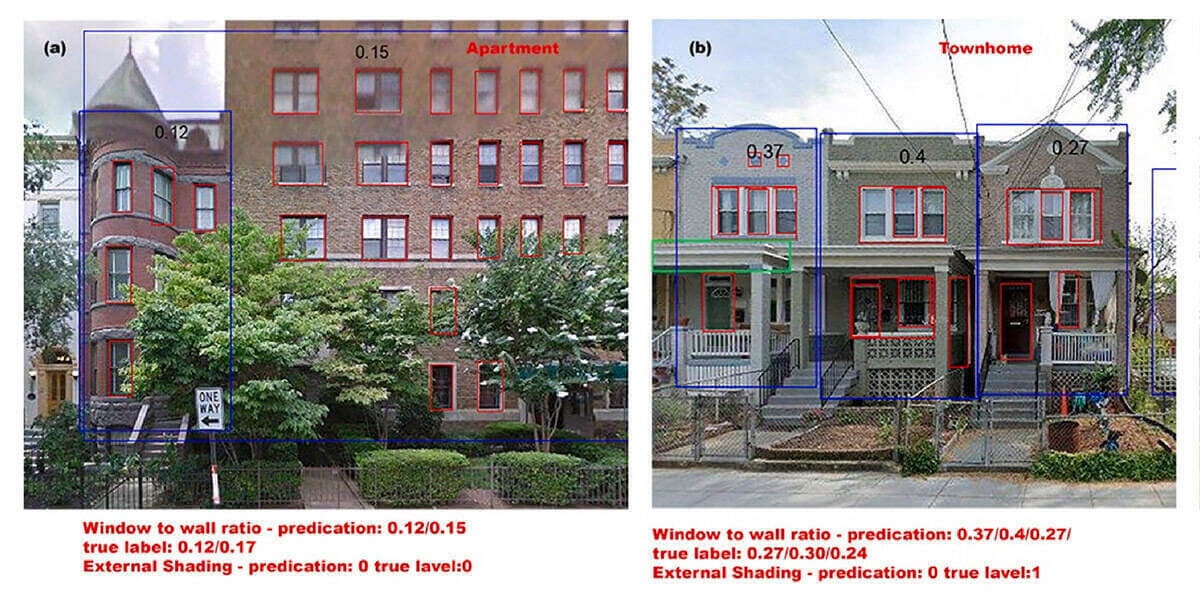Researchers use AI, Google Street View to predict household energy costs on large scale

Low-income households in the United States are bearing an energy burden that is three times that of the average household, according to the U.S. Department of Energy.
In total, more than 46 million U.S. households carry a significant energy burden — meaning they pay more than 6 percent of their gross income for basic energy expenses such as cooling and heating their homes.
Passive design elements like natural ventilation can play a pivotal role in reducing energy consumption. By harnessing ambient energy sources like sunlight and wind, they can create a more comfortable environment at little or no cost. However, data on passive design is scarce, making it difficult to assess the energy savings on a large scale.

To address that need, an interdisciplinary team of experts from the University of Notre Dame, in collaboration with faculty at the University of Maryland and University of Utah, have found a way to use artificial intelligence to analyze a household’s passive design characteristics and predict its energy expenses with more than 74 percent accuracy.
By combining their findings with demographic data including poverty levels, the researchers have created a comprehensive model for predicting energy burden across 1,402 census tracts and nearly 300,000 households in the Chicago metropolitan area. Their research was published this month in the journal Building and Environment.
The results yield invaluable insights for policymakers and urban planners, said Ming Hu, associate dean for research, scholarship and creative work in the School of Architecture, allowing them to identify neighborhoods that are most vulnerable — and paving the way toward smart and sustainable cities.
“When families cannot afford air conditioning or heat, it can lead to dire health risks,” Hu said. “And these risks are only exacerbated by climate change, which is expected to increase both the frequency and intensity of extreme temperature events. There is an urgent and real need to find low-cost, low-tech solutions to help reduce energy burden and to help families prepare for and adapt to our changing climate.”
In addition to Hu, who is a concurrent associate professor in the College of Engineering, the Notre Dame research team includes Chaoli Wang, a professor of computer science and engineering; Siyuan Yao, a doctoral student in the Department of Computer Science and Engineering; Siavash Ghorbany, a doctoral student in the Department of Civil and Environmental Engineering and Earth Science; and Matthew Sisk, an associate professor of the practice in the Lucy Family Institute for Data and Society.

Their research, which was funded by the Lucy Institute as part of the Health Equity Data Lab, focused on three of the most influential factors in passive design: the size of windows in the dwelling, the types of windows (operable or fixed) and the percent of the building that has proper shading.
Using a convolutional neural network, the team analyzed Google Street View images of residential buildings in Chicago and then performed different machine learning methods to find the best prediction model. Their results show that passive design characteristics are associated with average energy burden and are essential for prediction models.
“The first step toward mitigating the energy burden for low-income families is to get a better understanding of the issue and to be able to measure and predict it,” Ghorbany said. “So, we asked, ‘What if we could use everyday tools and technologies like Google Street View, combined with the power of machine learning, to gather this information?’ We hope it will be a positive step toward energy justice in the United States.”
The resulting model is easily scalable and far more efficient than previous methods of energy auditing, which required researchers to go building by building through an area.
Over the next few months, the team will work with Notre Dame’s Center for Civic Innovation to evaluate residences in the local South Bend and Elkhart communities. Being able to use this model to quickly and efficiently get information to the organizations who can help local families is an exciting next step for this work, Sisk said.
“When you have an increased energy burden, where is that money being taken away from? Is it being taken from educational opportunities or nutritious food? Is it then contributing to that population becoming more disenfranchised as time goes on?” Sisk said. “When we look at systemic issues like poverty, there is no one thing that will fix it. But when there’s a thread we can pull, when there are actionable steps that can start to make it a little bit better, that’s really powerful.”
The researchers are also working toward including additional passive design characteristics in the analysis, such as insulation, cool roofs and green roofs. And eventually, they hope to scale the project up to evaluate and address energy burden disparities at the national level.
For Hu, the project is emblematic of the University’s commitments to both sustainability and helping a world in need.
“This is an issue of environmental justice. And this is what we do so well at Notre Dame — and what we should be doing,” she said. “We want to use advancements like AI and machine learning not just because they are cutting-edge technologies, but for the common good.”
Contact: Carrie Gates, associate director of media relations, 574-993-9220 or c.gates@nd.edu
Latest ND NewsWire
- Smarter tools for policymakers: Notre Dame researchers target urban carbon emissions, building by buildingCarbon emissions continue to increase at record levels, fueling climate instability and worsening air quality conditions for billions in cities worldwide. Yet despite global commitments to carbon neutrality, urban policymakers still struggle to implement effective mitigation strategies at the city scale. Now, researchers at Notre Dame’s School of Architecture, the College of Engineering and the Lucy Family Institute for Data & Society are working to reduce carbon emissions through advanced simulations and a novel artificial intelligence-driven tool, EcoSphere.
- Notre Dame Lead Innovation Team partners with local WIC program to identify, prevent lead poisoning in childrenB.A.B.E. store “shoppers” now have something new to help their families: free lead screening kits offered by the University of Notre Dame’s Lead Innovation Team.
- Vatican honors Martin and Carmel Naughton with papal awardThe late Pope Francis, in one of his last acts, conferred the honour of the Order of Saint Gregory the Great upon Carmel and Martin Naughton, Trustee Emeritus of the University of Notre Dame. The papal honor is in recognition of the Naughtons’ outstanding philanthropy in the areas of education and the arts, particularly in the provision of philanthropic support and scholarships to Catholic education at the University of Notre Dame and Kylemore Abbey, and in their transformative contributions to higher education in Ireland.
- Brain tumor growth patterns may help inform patient care managementAssistant Professor Meenal Datta (University of Notre Dame/Wes Evard) A team of researchers from the University of Notre Dame, Harvard Medical School/Massachusetts General Hospital, and Boston University has developed a technique for measuring a brain tumor’s mechanical force and a new model to estimate how much brain tissue a patient has lost.
- Notre Dame elects two new TrusteesTwo new Trustees — John F. Crowley and Danielle Walker Merfeld — have been elected to serve on the University of Notre Dame’s Board of Trustees effective July 1. …
- From reaction to resolution: The future of allergy treatmentTwelve-year-old Lauren Eglite was thrilled to attend a Notre Dame football game with her father, Erik, in 2017, even though her acute peanut allergy demands constant vigilance. She was even more excited when the stadium’s brand-new video board aired an NBC Fighting…












